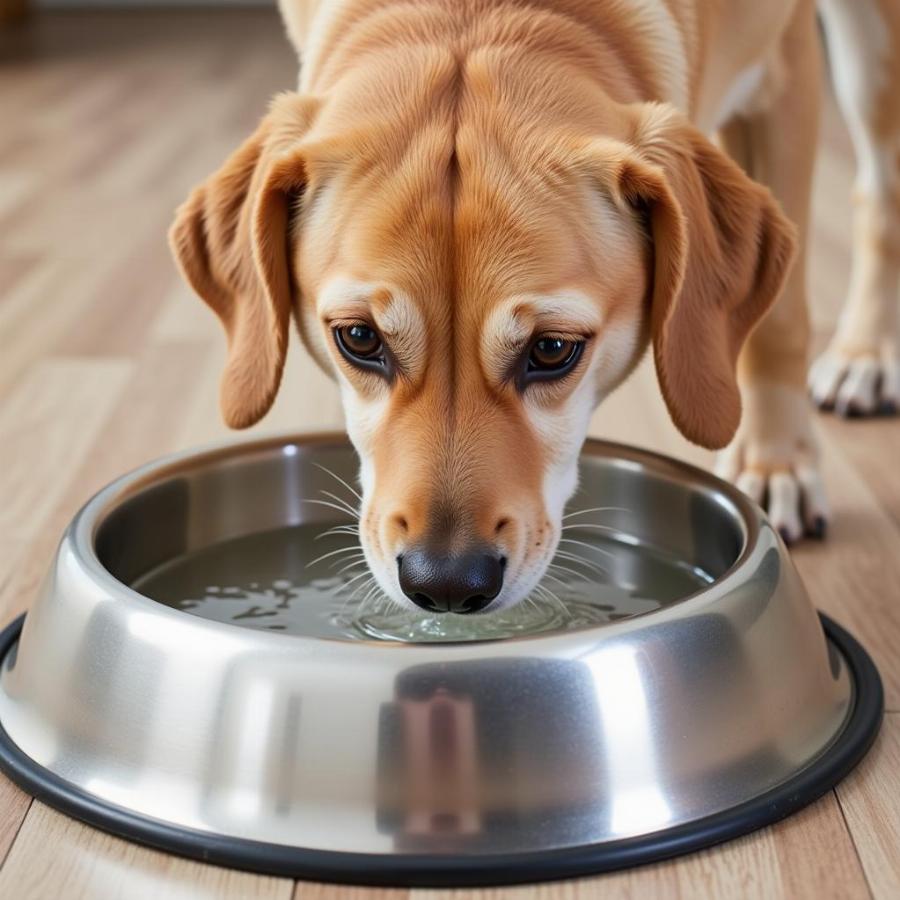A dog’s crusty nose can be concerning for any pet owner. While a little dryness can be normal, excessive crusting can sometimes indicate an underlying issue. Understanding the causes of a dog crusty nose, how to distinguish normal dryness from something more serious, and when to seek veterinary attention is crucial for responsible pet ownership. This article will delve into the various reasons behind a dog crusty nose, offering practical advice and solutions to ensure your furry friend’s well-being.
What Causes a Dog Crusty Nose?
Several factors can contribute to a dog crusty nose, ranging from simple environmental factors to more complex medical conditions. It’s important to consider all possibilities to determine the best course of action.
Environmental Factors
Sometimes, a dog’s crusty nose is simply a result of their environment. Dry air, particularly during winter months, can dry out a dog’s nose, leading to crusting. Similarly, excessive sun exposure can cause sunburn and subsequent crusting, especially in dogs with lighter-colored noses. Allergens, such as pollen or dust, can also irritate the nasal passages, causing inflammation and dryness.
Dehydration
Dehydration is another common culprit of a dog crusty nose. Ensure your dog has access to fresh, clean water at all times. If you suspect dehydration, offer your dog small amounts of water frequently.
Medical Conditions
While often benign, a crusty nose can be a symptom of various medical conditions. Allergies, autoimmune disorders, and even certain types of cancer can manifest as nasal dryness and crusting. If your dog’s crusty nose is accompanied by other symptoms like sneezing, discharge, or changes in appetite, it’s essential to consult a veterinarian.
When to Worry About a Dog Crusty Nose?
Knowing when a dog crusty nose warrants concern can be tricky. While occasional dryness is normal, persistent crusting or crusting accompanied by other symptoms should be investigated.
Signs to Watch For
If you notice any of the following along with a crusty nose, contact your vet:
- Excessive sneezing or nasal discharge
- Changes in appetite or lethargy
- Bleeding or cracking of the nose
- Swelling around the nose
- Difficulty breathing
Consulting Your Veterinarian
Your veterinarian can diagnose the underlying cause of your dog’s crusty nose and recommend appropriate treatment. This might involve allergy testing, skin scrapings, or blood tests. Early diagnosis and treatment can prevent potential complications and ensure your dog’s comfort and well-being.
Home Remedies for Dog Crusty Nose
For mild cases of dog crusty nose caused by environmental factors, several home remedies can provide relief.
Applying a Nose Balm
Applying a dog-specific nose balm can help moisturize and soothe a dry, crusty nose. Look for balms made with natural ingredients like coconut oil or shea butter. Avoid using human lip balms, as some ingredients can be toxic to dogs. You can find more helpful tips in our article on what can i put on my dog’s dry nose.
Humidifying the Air
A humidifier can add moisture to the air, preventing your dog’s nose from drying out, especially during the winter months. Make sure to clean the humidifier regularly to prevent bacterial growth.
Ensuring Proper Hydration
Ensure your dog has constant access to fresh water. You might consider adding a little flavor to their water, like chicken broth (ensure it’s low-sodium), to encourage them to drink more. For more remedies, visit our page on crusty dog nose home remedy.
 Dog Drinking Water from a Bowl
Dog Drinking Water from a Bowl
Is it Nasal Hyperkeratosis?
Sometimes, a crusty nose can be a sign of nasal hyperkeratosis, a condition where the skin on the nose produces excess keratin, resulting in a thickened, crusty appearance. This can be a primary condition or secondary to other health issues. If you suspect hyperkeratosis, consult with your veterinarian for a proper diagnosis and treatment plan. Learn more about this condition on our dedicated page on keratosis in dogs. It’s important to differentiate a simply dry nose from a more serious condition like this, similar to discerning between a dry nose and a more complex issue like when a dog’s nose is crusty and dry. A fungal infection is another potential cause, which you can read more about in our article on fungal infection in dogs nose.
Conclusion
A dog crusty nose can range from a simple case of dryness to a symptom of an underlying medical issue. By observing your dog closely, recognizing potential warning signs, and seeking veterinary care when necessary, you can ensure your furry friend receives the appropriate care and maintains a healthy, happy snout.
FAQs
- Is a dry nose always a sign of illness in dogs? No, a dry nose can be normal, especially after sleeping or in dry environments.
- Can I use human lip balm on my dog’s nose? No, certain ingredients in human lip balms can be toxic to dogs.
- How can I tell if my dog is dehydrated? Check for tacky gums, sunken eyes, and loss of skin elasticity.
- What should I do if my dog’s nose is bleeding? Apply gentle pressure and contact your veterinarian immediately.
- Can allergies cause a crusty nose in dogs? Yes, allergies can cause nasal inflammation and dryness.
- What are the treatment options for nasal hyperkeratosis? Treatment options vary depending on the severity and underlying cause, and may include topical medications or surgical removal of the excess keratin.
- How can I prevent my dog’s nose from getting crusty? Ensure adequate hydration, use a humidifier in dry environments, and protect their nose from excessive sun exposure.
Beaut Dogs is your trusted source for all things related to dog care. We provide expert advice and resources to help you understand and care for your canine companion. When you need assistance, don’t hesitate to contact us at Email: [email protected] for detailed and accurate information from our Beaut Dogs team. Visit us at https://beautdogs.com.